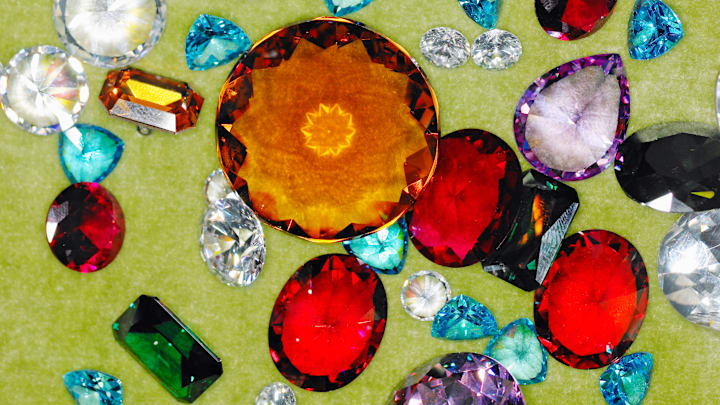Precious gems and stones—long valued for their rarity, beauty, and fabled powers—have been associated with the months of the year since antiquity. But it wasn’t until 1912, when the American National Retail Jeweler’s Association (now the Jewelers of America) met in Kansas City, that the first modern list of birthstones was standardized.
Just as many-faceted as the birthstones themselves, though, are the origins of their names. A great many of them came into English in the early 1200s to 1300s and share a similar lineage: loaned from French, filtered from Latin, borrowed from Greek, which often adopted older Semitic or Sanskrit words. While there are variations in some of the months’ birthstones, here are 12 of their etymologies, unearthed.
Garnet

January’s birthstone, garnet, is actually a group of several related silicate minerals. They’re most famously red, but can be found in several colors, including green. The name likely comes from the Latin granatum, meaning “pomegranate,” due to the likeness of the gem’s most famous color and shape to the small seeds and red flesh of the fruit. Another hypothesis is that it’s from the Latin granum for "grain," in this case referring to a red dye.
Amethyst

Amethyst is February’s birthstone, a deep purple variety of quartz. Its root, the Greek amethystos, literally means “not drunk,” as the stone was thought to prevent intoxication. Ancient imbibers wore amethyst jewelry or drank from amethyst vessels in the belief that they could party without the consequences.
Bloodstone

One of March’s birthstones is the bloodstone, a dark green chalcedony (a mixture of quartz and mogánite) speckled with red hematite that resemble drops of blood (hence the name). The ancient Greeks had a similar idea with hematite, an iron oxide often reddish-brown in hue, whose name comes from the Greek for “blood-like.” In the Middle Ages, bloodstone was believed to have the power to stanch blood—and even make people invisible.
Diamond

They say diamonds are forever—and etymologists would agree. The name for April’s carbon birthstone, the hardest natural substance in the world, ultimately comes from the Latin adamas, “hardest.” Some scholars think adamas joins Greek roots meaning “not conquered,” hence “invincible”; others suspect it was just borrowed from an ancient Semitic word. Via Latin, adamas also gives us adamant, a word historically associated with metals and stones of surpassing strength before describing someone as “unshakeable.”
Emerald

May birthdays boast the bright green beryl known as the emerald, believed to ward off witchcraft and aid childbirth in the Middle Ages and Renaissance. Emerald, after many cuts in French and Latin, comes, incredibly, from the Greek smargados, a word probably from the Semitic word for “bright” or “shine.”
Pearl

While not a gemstone (it’s referred to as a “gem material”), the oyster-originating pearl, one of June’s birthstones, is valued as a precious gem for its rarity and luster. The earliest use of pearl in English, documented around 1340, referred to the “pupil” or “lens” of the eye, iridescent as they can be. But the ancient Romans might have seen a different likeness in perula, the source of pearl, which is possibly a diminutive of perna, “haunch”—generally of ham—to describe a mollusk whose shape was deemed leg-like.
Ruby

The birthstone of July is the ruby, red in color and composed of corundum, an aluminum oxide with trace amounts of chromium. Describing something as ruby red, though, is etymologically redundant. Ruby is from the Latin rubeus, meaning “red.” In English, ruby referred to the precious stone (early 1300s) before it was extended as a color word (late 1400s).
Sardonyx

August is another month with several birthstones, including, historically, sardonyx. This stone features white layers of quartz in sandy-red sard, also a type of quartz, and those layers look like the thin, white bands on black onyx—thus sardonyx. Sard hails from Sardis, the capital of Lydia, an ancient kingdom once controlling western Turkey. And onyx means “nail” or “claw” in ancient Greek, because the stone’s markings were thought to resemble fingernails.
Sapphire

The rich blue of September’s honorary gem, the sapphire, is, like the ruby, a variety of corundum (other colors of corundum are referred to as “fancy sapphires”). Sapphire ultimately derives from the Greek sapphiros, which actually referred to lapis lazuli, a deep blue rock that’s most famous today for its use in paint. The deeper origins of sapphiros are obscure, though some scholars have argued for sanipriya, a Sanskrit word for a precious stone literally meaning “sacred to the planet Saturn.” During the Renaissance, some believed sapphires could cure anger and stupidity.
Opal

The origin of October’s iridescent opal may be Latin by way of Greek by way of Sanskrit: upala, meaning “gem” or “precious stone.” While the stone was smeared with various bad-luck-bringing superstitions starting in the 19th century, opal historically was believed to promote healthy eyesight—and even clairvoyance.
Topaz

November’s topaz, with its brownish yellow to blue luster, is an aluminum-fluoro-hydroxy-silicate. The word is rooted in the Greek topazos, which Roman scholar Pliny the Elder thought referred to a hard-to-reach island in the Red Sea, Topazios, from the Greek verb topazein, “to seek.” The island is now often identified as Zarbargad Island off Egypt. The Greeks may have borrowed topaz, alternatively, from the Sanskrit tapas, “heat” or “fire,” alluding to the stone’s blazing yellow hues.
Turquoise

Vivid greens and blues distinguish December’s birthstone, turquoise, a rare mineral composed of copper, aluminum, and phosphate. The name is simply an Old French adjective for “Turkish,” from pierre turquoise, or “Turkish stone.” This name alludes to the fact that Europeans in the Middle Ages associated the stone with the region of Turkestan or other historically Turkish-ruled territories.
Read More About Gemstones:
A version of this story originally ran in 2017; it has been updated for 2025.
